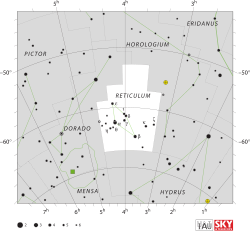Alpha Reticuli
| Observation data Epoch J2000.0 Equinox J2000.0 (ICRS) | |
|---|---|
| Constellation | Reticulum |
| Right ascension | 04h 14m 25.48414s[1] |
| Declination | −62° 28′ 25.8917″[1] |
| Apparent magnitude (V) | 3.315[2] |
| Characteristics | |
| Spectral type | G8 II-III[3] |
| U−B color index | +0.63[4] |
| B−V color index | +0.922[2] |
| R−I color index | +0.659[2] |
| Astrometry | |
| Radial velocity (Rv) | +35.5[5] km/s |
| Proper motion (μ) | RA: +41.97[1] mas/yr Dec.: +49.42[1] mas/yr |
| Parallax (π) | 20.18 ± 0.10 mas[1] |
| Distance | 161.6 ± 0.8 ly (49.6 ± 0.2 pc) |
| Absolute magnitude (MV) | −0.17 ± 0.05[6] |
| Details | |
| Mass | 3.11 ± 0.06[6] M☉ |
| Radius | 12.8 ± 0.6[6] R☉ |
| Luminosity | 240[7] L☉ |
| Surface gravity (log g) | 2.69 ± 0.04[6] cgs |
| Temperature | 5,196[6] K |
| Metallicity [Fe/H] | 0.07[6] dex |
| Rotational velocity (v sin i) | 5.7[8] km/s |
| Age | 0.33 ± 0.02[6] Gyr |
| Other designations | |
| Database references | |
| SIMBAD | data |
Alpha Reticuli (Alpha Ret, α Reticuli, α Ret) is the Bayer designation the brightest star in the southern circumpolar constellation of Reticulum,[7] with an apparent visual magnitude of 3.3.[2] This appears to be a solitary star[11] located at a distance of 162 light-years from Earth.[1] Although it is bright enough to be seen with the naked eye, the declination of this star means that it is best viewed from the southern hemisphere and is only readily visible below the tropic of cancer.[7]
This star has more than three times the mass of the Sun and is about 330 million years old.[6] The spectrum of this star matches a stellar classification of G8 II-III,[3] with the luminosity class notation 'II-III' indicating it shows some traits of both a giant star and a bright giant. At this evolutionary stage, the atmosphere has expanded to almost thirteen times the radius of the Sun and the outer envelope has an effective temperature of 5,196 K.[6] X-ray emission has been detected from this star, with an estimated luminosity of 3 × 1029 erg s−1.[12]
Alpha Reticuli has a 12th-magnitude visual companion, CCDM J04144-6228B, at an angular separation of 48 arcseconds away along a position angle of 355°.[10] Since the two stars share a common proper motion across the celestial sphere, it is possible that Alpha Reticuli, rather than being solitary, may instead be the primary component of a binary star system with an orbital period is at least 60,000 years.[7]
Naming
In Chinese caused by adaptation of the European southern hemisphere constellations into the Chinese system, 夾白 (Jiá Bái), meaning White Patches Attached, refers to an asterism consisting of α Reticuli and θ Doradus. Consequently, α Reticuli itself is known as 夾白二 (Jiá Bái èr, English: the Second Star of White Patches Attached.)[13]
References
- ^ a b c d e f van Leeuwen, F. (November 2007), "Validation of the new Hipparcos reduction", Astronomy and Astrophysics, 474 (2): 653–664, arXiv:0708.1752, Bibcode:2007A&A...474..653V, doi:10.1051/0004-6361:20078357
- ^ a b c d Gutierrez-Moreno, Adelina; et al. (1966), A System of photometric standards, vol. 1, Publicaciones Universidad de Chile, Department de Astronomy, pp. 1–17, Bibcode:1966PDAUC...1....1G
- ^ a b Houk, Nancy (1978), Michigan catalogue of two-dimensional spectral types for the HD stars, vol. 1, Ann Arbor: Dept. of Astronomy, University of Michigan, Bibcode:1975mcts.book.....H
- ^ HR 1336, database entry, The Bright Star Catalogue, 5th Revised Ed. (Preliminary Version), D. Hoffleit and W. H. Warren, Jr., CDS ID V/50. Accessed on line September 4, 2008.
- ^ Evans, D. S. (June 20–24, 1966), Batten, Alan Henry; Heard, John Frederick (eds.), The Revision of the General Catalogue of Radial Velocities, University of Toronto: International Astronomical Union, retrieved 2009-09-10
{{citation}}: Unknown parameter|booktitle=ignored (help) - ^ a b c d e f g h i da Silva, L.; et al. (November 2006), "Basic physical parameters of a selected sample of evolved stars", Astronomy and Astrophysics, 458 (2): 609–623, arXiv:astro-ph/0608160, Bibcode:2006A&A...458..609D, doi:10.1051/0004-6361:20065105
- ^ a b c d Alpha Ret, Jim Kaler, Stars. Accessed on line September 4, 2008.
- ^ Schröder, C.; Reiners, A.; Schmitt, J. H. M. M. (January 2009), "Ca II HK emission in rapidly rotating stars. Evidence for an onset of the solar-type dynamo", Astronomy and Astrophysics, 493 (3): 1099–1107, Bibcode:2009A&A...493.1099S, doi:10.1051/0004-6361:200810377
- ^ * alf Ret -- Star in double system, database entry, SIMBAD. Accessed on line September 4, 2008.
- ^ a b Entry 04144-6228, The Washington Double Star Catalog, United States Naval Observatory. Accessed on line September 4, 2008.
- ^ Eggleton, P. P.; Tokovinin, A. A. (September 2008), "A catalogue of multiplicity among bright stellar systems", Monthly Notices of the Royal Astronomical Society, 389 (2): 869–879, arXiv:0806.2878, Bibcode:2008MNRAS.389..869E, doi:10.1111/j.1365-2966.2008.13596.x
{{citation}}: CS1 maint: unflagged free DOI (link) - ^ Micela, G.; Favata, F.; Sciortino, S. (October 1997), "HIPPARCOS distances of X-ray selected stars: implications on their nature as stellar population", Astronomy and Astrophysics, 326: 221–227, Bibcode:1997A&A...326..221M
- ^ Template:Zh icon AEEA (Activities of Exhibition and Education in Astronomy) 天文教育資訊網 2006 年 7 月 27 日

